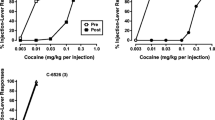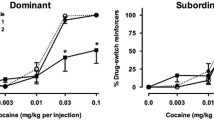Abstract
Rationale
Studies in socially housed monkeys have demonstrated an influence of position in the social dominance hierarchy on brain dopamine D2 receptors and the reinforcing effects of cocaine that dissipates after long-term cocaine self-administration.
Objective
The aims of the study were to examine the effects of abstinence from cocaine on D2 receptors in socially housed monkeys and to extend behavioral characterizations to measures of reactivity to a novel object.
Materials and methods
Twelve socially housed male cynomolgus monkeys with extensive cocaine self-administration experience were used (average lifetime intakes ∼270 and 215 mg/kg for dominant and subordinate monkeys, respectively). Abstinence lasted for approximately 8 months, after which D2 receptor availability was assessed using positron emission tomography and the D2 ligand [18F]fluoroclebopride. Reaction to novelty was also assessed in these subjects as well as nine individually housed monkeys.
Results
During abstinence, D2 receptor availability in the caudate nucleus was significantly higher in dominant versus subordinate monkeys. Average latency to touch a novel object was also significantly higher in dominant monkeys compared to subordinates or individually housed monkeys. In socially experienced monkeys, a significant positive correlation was observed between caudate nucleus D2 receptor availability and latencies to touch the novel object.
Conclusions
Although chronic cocaine self-administration blunts the ability of social dominance to alter D2 receptor availability and sensitivity to the reinforcing effects of cocaine, this influence reemerges during abstinence. In addition, the data suggest that prior experience with social dominance can lead to longer latencies in reaction to novelty—a personality trait associated with low vulnerability to cocaine abuse.



Similar content being viewed by others
References
Bardo MT, Donohew RL, Harrington NG (1996) Psychobiology of novelty seeking and drug seeking behavior. Behav Brain Res 77:23–43
Czoty PW, Morgan D, Shannon EE, Gage HD, Nader MA (2004) Characterization of dopamine D1 and D2 receptor function in socially housed cynomolgus monkeys self-administering cocaine. Psychopharmacology 174:381–388
Czoty PW, Gage HD, Nader MA (2005a) PET imaging of striatal dopamine D2 receptors in nonhuman primates: increases in availability produced by chronic raclopride treatment. Synapse 58:215–219
Czoty PW, McCabe C, Nader MA (2005b) Assessment of the reinforcing strength of cocaine in socially housed monkeys using a choice procedure. J Pharmacol Exp Ther 312:96–102
Czoty PW, Gould RW, Nader MA (2009) Relationship between social rank and cortisol and testosterone concentrations in male cynomolgus monkeys (Macaca fascicularis). J Neuroendocrinol 21:68–76
Dalley JW, Fryer TD, Brichard L, Robinsin ES, Theobald DE, Laane K, Pena Y, Murphy ER, Shah Y, Probst K, Abakumova I, Aigbirhio FI, Richards HK, Hong Y, Baron JC, Everitt BJ, Robbins TW (2007) Nucleus accumbens D2/3 receptors predict trait impulsivity and cocaine reinforcement. Science 315:1267–1270
Dawe S, Loxton NJ (2004) The role of impulsivity in the development of substance abuse and eating disorders. Neurosci Biobehav Rev 28:343–351
DeGrado TR, Turkington TG, Williams JJ, Stearns CW, Hoffman JM, Coleman RE (1994) Performance characteristics of a whole-body PET scanner. J Nucl Med 35:1398–1406
Dellu F, Piazza PV, Mayo W, Le Moal M, Simon H (1996) Novelty-seeking in rats—behavioral characteristics and possible relationship with the sensation-seeking trait in man. Neuropsychobiology 34:136–145
Grant KA, Shively CA, Nader MA, Ehrenkaufer RL, Line SW, Morton TE, Gage HD, Mach RH (1998) The effect of social status on striatal dopamine D2 receptor binding characteristics in cynomolgus monkeys assessed with positron emission tomography. Synapse 29:80–83
Hooks MS, Jones GH, Smith AD, Neill DB, Justice JB Jr (1991) Response to novelty predicts the locomotor and nucleus accumbens response to cocaine. Synapse 9:121–128
Kaplan JR, Manuck SB, Clarkson TB, Lusso FM, Taub DM (1982) Social status, environment, and atherosclerosis in cynomolgus monkeys. Arteriosclerosis 2:359–368
Logan J, Fowler JS, Volkow ND, Wang GJ, Ding YS, Alexoff DL (1996) Distribution volume ratios without blood sampling from graphical analysis of PET data. J Cereb Blood Flow Metab 16:834–840
Mach RH, Elder ST, Morton TE, Nowak PA, Evora PH, Scripko JG, Luedtke RR, Unsworth CD, Filtz T, Rao AV et al (1993a) The use of [18F]4-fluorobenzyl iodide (FBI) in PET radiotracer synthesis: model alkylation studies and its application in the design of dopamine D1 and D2 receptor-based imaging agents. Nucl Med Biol 20:777–794
Mach RH, Luedtke RR, Unsworth CD, Boundy VA, Nowak PA, Scripko JG, Elder ST, Jackson JR, Hoffman PL, Evora PH et al (1993b) 18F-labeled benzamides for studying the dopamine D2 receptor with positron emission tomography. J Med Chem 36:3707–3720
Mach RH, Nader MA, Ehrenkaufer RL, Line SW, Smith CR, Luedtke RR, Kung MP, Kung HF, Lyons D, Morton TE (1996) Comparison of two fluorine-18 labeled benzamide derivatives that bind reversibly to dopamine D2 receptors: in vitro binding studies and positron emission tomography. Synapse 24:322–333
Mach RH, Nader MA, Ehrenkaufer RL, Line SW, Smith CR, Gage HD, Morton TE (1997) Use of positron emission tomography to study the dynamics of psychostimulant-induced dopamine release. Pharmacol Biochem Behav 57:477–486
Morgan D, Grant KA, Prioleau OA, Nader SH, Kaplan JR, Nader MA (2000) Predictors of social status in cynomolgus monkeys (Macaca fascicularis) after group formation. Am J Primatol 52:115–131
Morgan D, Grant KA, Gage HD, Mach RH, Kaplan JR, Prioleau O, Nader SH, Buchheimer N, Ehrenkaufer RL, Nader MA (2002) Social dominance in monkeys: dopamine D2 receptors and cocaine self-administration. Nat Neurosci 5:169–174
Mufano MR, Yalcon B, Wills-Owen SA, Flint J (2008) Association of the dopamine D4 receptor (DRD4) gene and approach-related personality traits: meta-analysis and new data. Biol Psychiatry 63:197–206
Nader MA, Czoty PW (2005) PET imaging studies of dopamine D2 receptors in monkey models of cocaine abuse: genetic predisposition versus environmental modulation. Am J Psychiatry 162:1473–1482
Nader MA, Grant KA, Gage HD, Ehrenkaufer RL, Kaplan JR, Mach RH (1999) PET imaging of dopamine D2 receptors with [18F]fluoroclebopride in monkeys: effects of isoflurane- and ketamine-induced anesthesia. Neuropsychopharmacology 21:589–596
Nader MA, Morgan D, Gage HD, Nader SH, Calhoun T, Buchheimer N, Ehrenkaufer R, Mach RH (2006) PET imaging of dopamine D2 receptors during chronic cocaine self-administration in monkeys. Nature Neurosci 9:1050–1056
Perry JL, Larson EB, German JP, Madden GJ, Carroll ME (2005) Impulsivity (delay discounting) as a predictor of acquisition of IV cocaine self-administration in female rats. Psychopharmacology 178:193–201
Piazza PV, Deminiere JM, Le Moal M, Simon H (1989) Factors that predict individual vulnerability to amphetamine self-administration. Science 245:1511–1513
Piazza PF, Rouge-Pont F, Deminiere JM, Kharoubi M, Le Moal M, Siman H (1991) Dopamine activity is reduced in the prefrontal cortex and increased in the nucleus accumbens of rats predisposed to develop amphetamine self-administration. Brain Res 567:169–174
Piazza PV, Deroche-Gamonet V, Rouge-Pont F, Le Moal M (2000) Vertical shifts in self-administration dose–response functions predict a drug-vulnerable phenotype predisposed to addiction. J Neurosci 20:4226–4232
Retz W, Rosler M, Supprian T, Retz-Junginger P, Thome J (2003) Dopamine D3 receptor gene polymorphism and violent behavior: relation to impulsiveness and ADHD-related psychopathology. J Neural Transm 110:561–572
Riddick NV, Czoty PW, Gage HD, Kaplan JR, Nader SH, Icenhower M, Pierre PJ, Bennett A, Garg PK, Nader MA (2009) Behavioral and neurobiological characteristics influencing social hierarchy formation in female cynomolgus monkeys. Neuroscience 158:1257–1265
Rouge-Pont F, Piazza PV, Kharouby M, Le Moal M, Simon H (1993) Higher and longer stress-induced increase in dopamine concentrations in the nucleus accumbens of animals predisposed to amphetamine self-administration. A microdialysis study Brain Res 602:169–174
Stoffel EC, Cunningham KA (2007) The relationship between the locomotor response to a novel environment and behavioral disinhibition in rats. Drug Alcohol Depend 92:69–78
Thanos PK, Volkow ND, Freimuth P, Umrgaki H, Ikari H, Roth G, Ingram DK, Hitzemann R (2001) Overexpression of dopamine D2 receptors reduces alcohol self-administration. J Neurochem 78:1094–1103
Verdejo-Garcia A, Laerence AJ, Clark L (2008) Impulsivity as a vulnerability marker for substance-use disorders: Review of findings form high-risk research, problem gamblers and genetic association studies. Neurosci Biobehav Rev 32:777–810
Volkow ND, Wang GJ, Fowler JS, Logan J, Gatley SJ, Gifford A, Hitzemann R, Ding YS, Pappas N (1999) Prediction of reinforcing responses to psychostimulants in humans by brain D2 dopamine receptors. Amer J Psychiatry 156:1440–1443
Zald DH, Cowan RL, Riccardi P, Baldwin RM, Ansari MS, Li R, Shelby ES, Smith CE, McHugo M, Kessler RM (2008) Midbrain dopamine receptor availability is inversely associated with novelty seeking traits in humans. J Neurosci 28:14372–14378
Acknowledgments
This research was supported by National Institute on Drug Abuse grant R37 DA10584. The authors report no conflict of interest and would like to acknowledge the assistance with novel object reactivity assessments by Drs. Allyson Bennett and Peter Pierre and the technical assistance of Kimberly Black, Robert W. Gould and Michelle Icenhower.
Author information
Authors and Affiliations
Corresponding author
Rights and permissions
About this article
Cite this article
Czoty, P.W., Gage, H.D. & Nader, M.A. Differences in D2 dopamine receptor availability and reaction to novelty in socially housed male monkeys during abstinence from cocaine. Psychopharmacology 208, 585–592 (2010). https://doi.org/10.1007/s00213-009-1756-4
Received:
Accepted:
Published:
Issue Date:
DOI: https://doi.org/10.1007/s00213-009-1756-4




